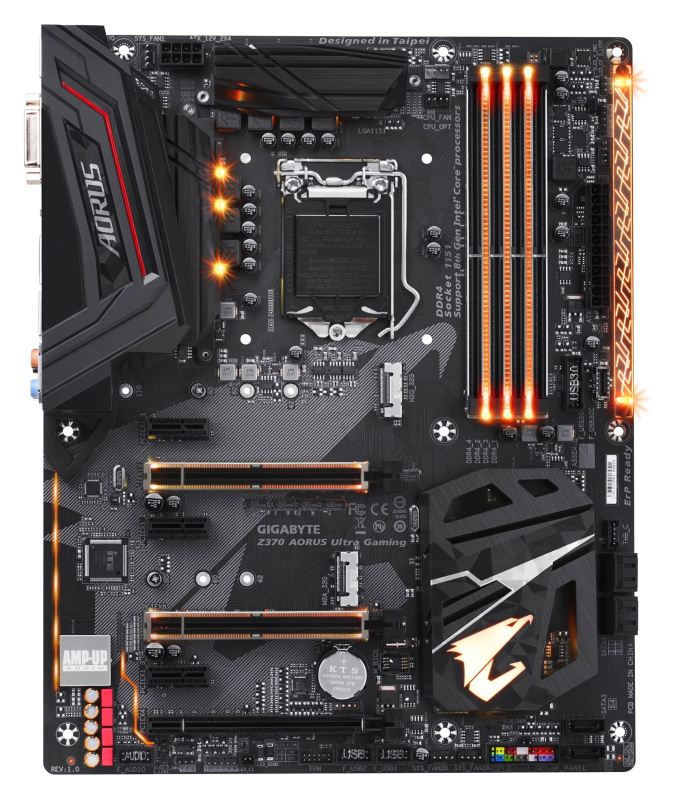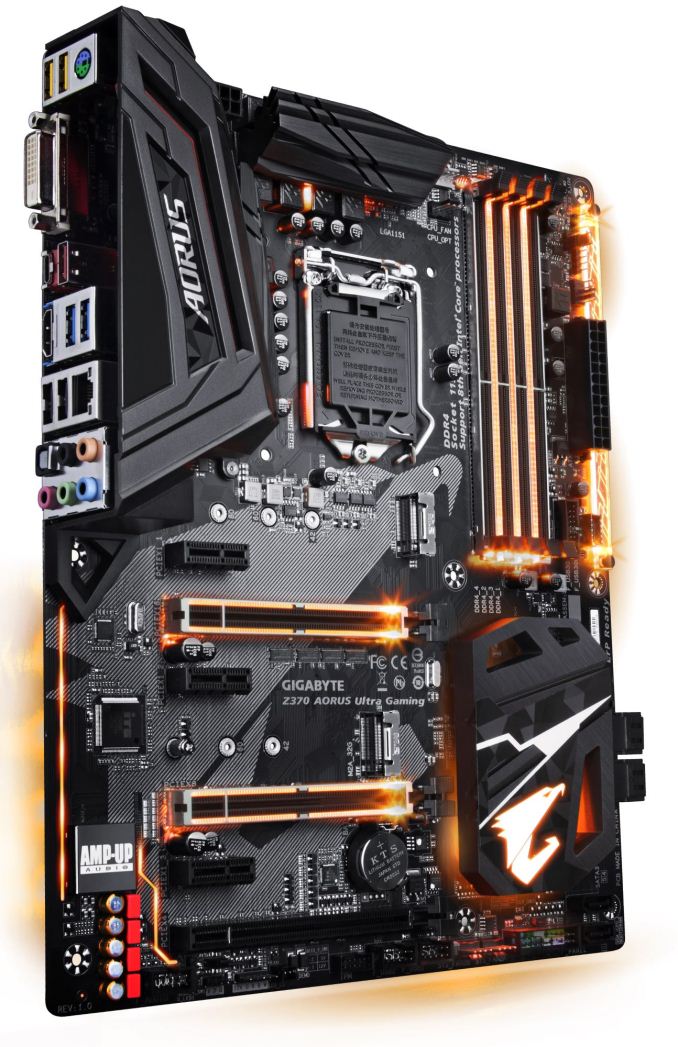Analyzing Z370 for Intel's 8th Generation Coffee Lake: A Quick Look at 50+ Motherboards
by Ian Cutress, Anton Shilov, Joe Shields & Gavin Bonshor on October 20, 2017 2:00 PM ESTGIGABYTE Z370 Ultra Gaming
The next board we will take a high-level look at is the Z370 Ultra Gaming. The Ultra Gaming appears to fall somewhere in the middle of the AORUS lineup offering a mix of features.
Appearance wise, the PCB is black with the AORUS bird stenciled in from the Audio area going through the PCIe slots and ending around the bottom of the CPU socket. RGB LEDs are used in multiple locations including around the VRM area, between the memory slots, and a strip on the right side going from mid-board to the top. The separation line between the audio section and the rest of the motherboard has LEDs, as well as the two fortified PCIe slots and the PCH heatsink. Compared to the Gaming 5 and Gaming 7, it loses LEDs on the VRM heatsink and back panel shroud. On the board there are also two 5-pin headers for external RGBW LED strips, both supporting true white, and two more regular RGB headers, all of which are controlled by the RGB Fusion Software. The Ultra Gaming board uses a different VRM with what looks like 7 phases as opposed to the 10 phase the Gaming 5/7 runs with. We can see it is using International Rectifier chokes, likely to be the same 40A/50A models we have seen on other GIGABYTE boards. Two separate heatsinks cover each set of VRMs to help keep them cool.
The board uses four reinforced memory slots supporting dual-channel DDR4 with capacity up to 64GB, and speeds supported up to DDR-4000. There are two steel protected full-length PCIe 3.0 slots, operating at x16 and x8 respectively, using lanes sourced from the CPU. There is another unprotected full-length PCIe 3.0 slot at the bottom of the board; it is limited to x4 bandwidth from the chipset and used for add-on cards. Additionally, there are three PCIe 3.0 x1 slots to round out PCIe capabilities. The board supports 2-way SLI via the reinforced slots, and 3-Way Crossfire using all the full-length PCIe slots.
For storage, the Z370 AORUS Ultra Gaming gives users a total of six SATA ports and two M.2 PCIe 3.0 x4 slots. The first M.2 connector can hold up to 110mm drives and is located above all the PCIe slots. The second slot, found between the second PCIe x1 slot and second full-length slot, supports up to 80 mm drives. There are several fan headers scattered around the board, five according to my cursory glance, located around the socket and to the right, as well across the bottom of the board. Audio duties are handled by the latest Realtek ALC1220 codec while networking is taken care of by a single Intel I219-V NIC. The Ultra Gaming also includes a Thunderbolt 3 header located just above the SATA ports for a TB3 add-in card.
The board supports USB 3.1 (10 Gbps) with a Type-A and Type-C headers found on the rear I/O only. There is a USB 3.1 (5 Gbps) header for the chassis, although we find four ports on the rear panel. There is a USB 3.1 (10 Gbps) style header on the board as well, although from what we can determine, this has only 3.1 (5 Gbps) bandwidth.
Boards further up the stack like the Gaming 5 offer an additional M.2 slot, or in the case of the Gaming 7, the additional M.2 slot and better audio hardware. The Ultra Gaming does not have onboard power and reset buttons nor a debug LED - it would appear these are options commonly targeted towards enthusiasts. In that respect, the stripped down Ultra Gaming is focusing on users who set the system up, then leave it until it is time to upgrade.













83 Comments
View All Comments
risa2000 - Saturday, October 21, 2017 - link
It seems that the PCB which holds the silicon has changed between the 7th and the 8th gen. So they most likely needed to validate the CPU. The fact that they did not move the notch means they just did not want to (could not) introduce a new socket. Either because there were so many of the old ones, or there was no time, or they did not want to push the cost to MB manufacturers to revalidate the new sockets.shabby - Friday, October 20, 2017 - link
For a split second i thought finally some x370 goodness... but no.Shame, shame, shame!
tamalero - Saturday, October 21, 2017 - link
I'm waiting for actual non clown disco BS Threadripper motherboards :(ikjadoon - Friday, October 20, 2017 - link
Amazingly well done. Excellent write-up.AbRASiON - Friday, October 20, 2017 - link
Stupid question, I got the AsRock simple ITX board and it won't turbo my CPU at all (8400) like no turbo PERIOD. It never ever goes over 2763mhz?Anyone got any ideas on this? Am I just stupid and this is normal behaviour or what?
https://forums.anandtech.com/threads/am-i-doing-so...
bernstein - Friday, October 20, 2017 - link
FYI: GIGABYTE Z370N-WiFi is also HDMI 2.0 capableByte - Friday, October 20, 2017 - link
If nothing else, Asus makes some damn good looking boards.docbones - Friday, October 20, 2017 - link
My big question still on the z370 is whats the 390 going to bring? Will the 370 not support a octocore chip?shabby - Friday, October 20, 2017 - link
This is intel we're talking aboot, new chip = new mobo period.Ro_Ja - Saturday, October 21, 2017 - link
Once Kaby Lake E is released, that's a new mobo again.